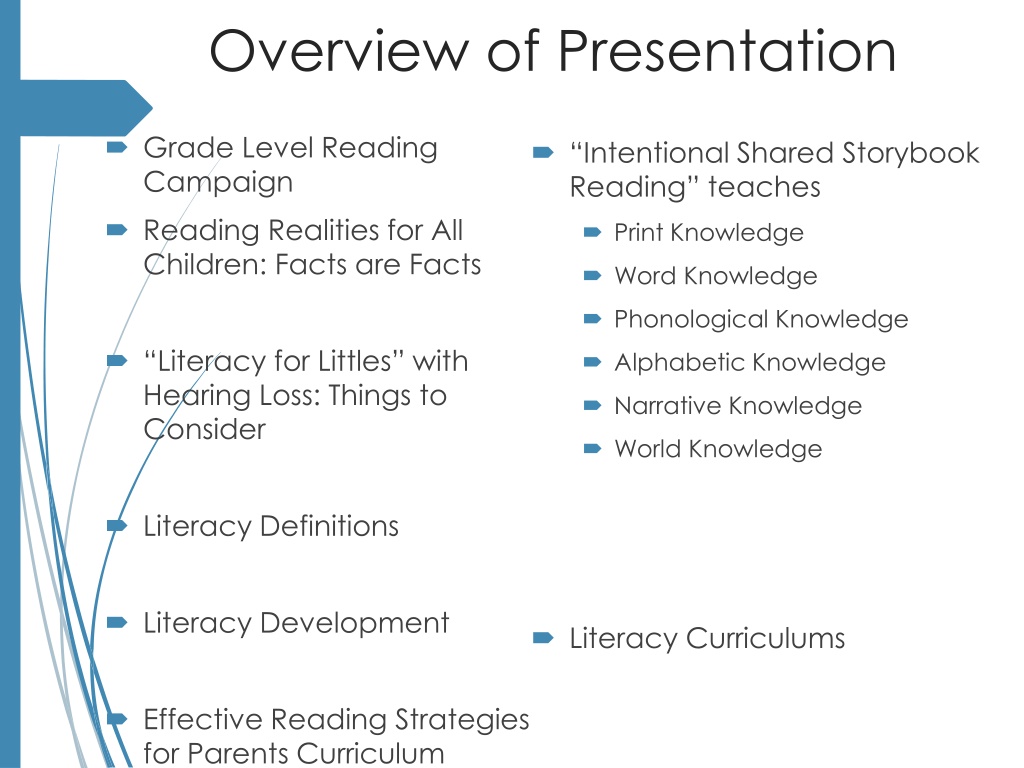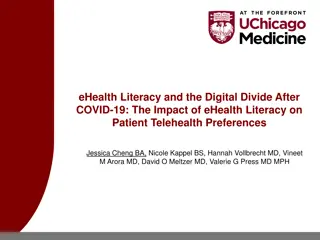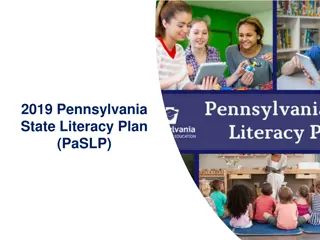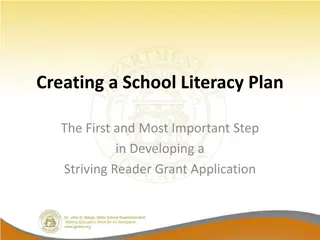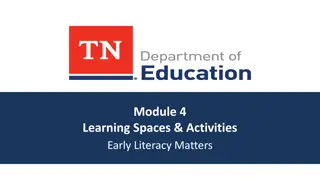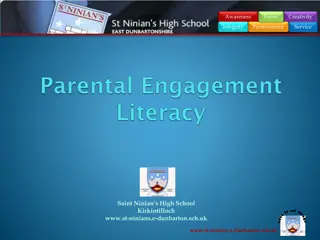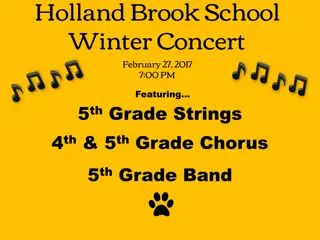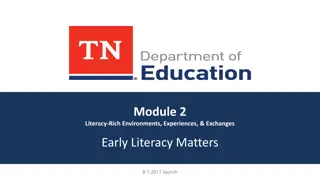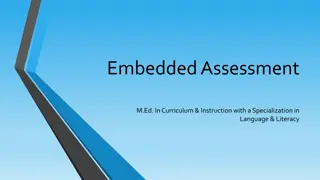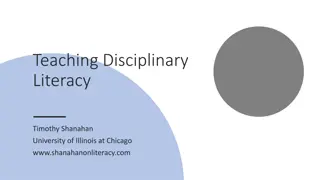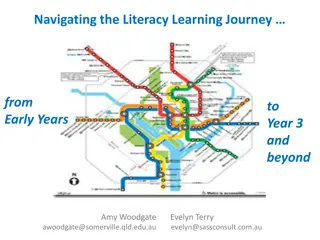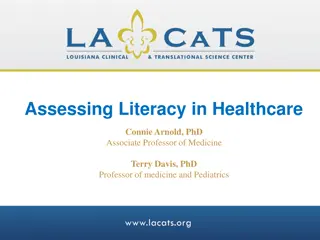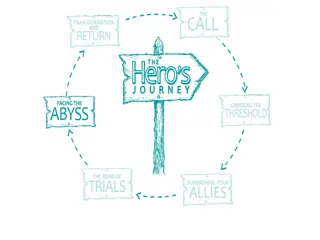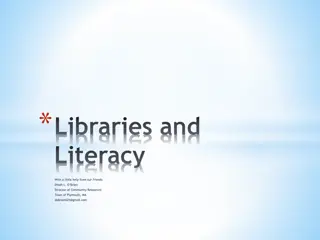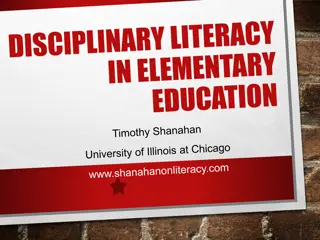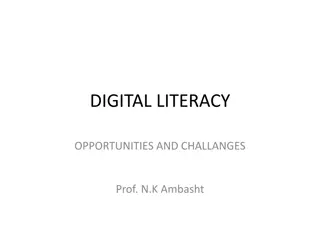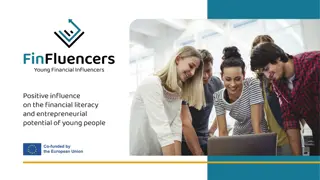Promoting Grade-Level Literacy Skills in Children
Discover the importance of developing grade-level literacy skills for children, especially by 3rd grade, to ensure academic success. Learn about a campaign focusing on 3rd-grade reading success, addressing the disparities in reading proficiency among low-income children, and strategies to support literacy development. Explore the impact of early exposure to language-rich environments and the critical role of shared storybook reading. Join the movement towards improving literacy outcomes for all children.
Download Presentation

Please find below an Image/Link to download the presentation.
The content on the website is provided AS IS for your information and personal use only. It may not be sold, licensed, or shared on other websites without obtaining consent from the author. Download presentation by click this link. If you encounter any issues during the download, it is possible that the publisher has removed the file from their server.
E N D
Presentation Transcript
Overview of Presentation Grade Level Reading Campaign Reading Realities for All Children: Facts are Facts Intentional Shared Storybook Reading teaches Print Knowledge Word Knowledge Phonological Knowledge Literacy for Littles with Hearing Loss: Things to Consider Alphabetic Knowledge Narrative Knowledge World Knowledge Literacy Definitions Literacy Development Literacy Curriculums Effective Reading Strategies for Parents Curriculum
Why This Presentation? Reading is foundational to academic success Up through 3rdgrade, children learn to read; After 3rd grade, children read to learn A child who is reading at grade level by 3rdgrade is more likely to succeed in later grades and master complex subject matter Children who are reading proficiently by third grade are 4 times more likely to graduate high school on time We want to show you what it takes to develop grade-level literacy skills and how it s done
The Campaign The Campaign for Grade-Level Reading: 3rdGrade Reading Success Matters! http://gradelevelreading.net/ Research shows that proficiency in reading by the end of third grade enables students to shift from learning to read to reading to learn, and to master the more complex subject matter they encounter in the fourth grade curriculum. Most students who fail to reach this critical milestone falter in the later grades and often drop out before earning a high school diploma. Yet two-thirds of U.S. fourth graders are not proficient readers, according to national reading assessment data. This disturbing statistic is made even worse by the fact that more than four out of every five low-income students miss this critical milestone. About 67 percent nationwide and more than 80 percent of those from low-income families are not proficient readers by the end of third grade
The Campaign As early as 18 months, children in low-income families begin to fall behind in vocabulary development and other skills critical for school success. 61 Percent of children in low income families have no children s books at home. Children in low-income families hear as many as 30 million fewer words than their more affluent peers. By age 2, poor children are already behind their peers in listening, counting, and other skills essential to literacy. A child s vocabulary, as early as age 3, can predict third grade reading achievement. By age 5, a typical middle-class child recognizes 22 letters of the alphabet, compared to 9 for a child from a low-income family. https://gradelevelreading.net/our-work/school-readiness
Fueling the Campaign Goal: By 2020, a dozen states or more will increase, by at least 100%, the number of low-income children reading proficiently at the end of third grade Funding: https://gradelevelreading.net/about- us/campaign-investors Partners: https://gradelevelreading.net/about- us/campaign-partners Grade-Level Reading Communities Network https://gradelevelreading.net/our- network/participating-communities
Where Do Children Who Are Deaf or Hard of Hearing Fit Into This Equation? Children who are deaf or hard of hearing have the same need to read and stay on course as children who are not deaf or hard of hearing .of course! Birth to Three and Pre-School: Because of decreased auditory access: language, vocabulary, pre- literacy and literacy activities may not be as available to children who are deaf or hard of hearing School-age: Because of decreased auditory access coupled with the fast-paced classroom, increased rate of learning, reading to learn, and expectations to meet outcomes, many children who are deaf or hard of hearing are likely to need adaptations to their education in the form of one or more of the following: classroom accommodations, modifications, related services and/or supplementary aids and services to truly have access to instruction.
Pause for Seriously Important Information Supports Modifications Accommodations Related Services Supplementary Aids and Services https://successforkidswithhearingloss.com/for- parents/supports-modifications- accommodations-for-students/
The Campaign for Grade- Level Reading 3rd Grade Reading Success Matters Betty Hart and Todd R. Risley (1995) published a study that highlighted the close link between children s academic success at ages 9 and 10 and their verbal interaction with their parents during the first years of life which became: The 30 Million Word Gap The Role of Parent-Child Verbal Interaction in Language and Literacy Development
Because of Hart & Risley and other researchers Parent-child verbal interaction is strongly associated with the development of children s vocabulary and emergent literary skills. Parent- child verbal interaction is associated with development of conceptual knowledge (e.g. vocabulary, understanding of narrative and story structure) which together with subsequent development of decoding skills (e.g. phonological awareness, letter knowledge) leads to literacy. Researchers link the achievement gap between high and low SES Verbal interaction between parent and child is part of a constellation of income-associated home characteristics and family practices that influence reading readiness. http://www.aecf.org/resources/the-30-million-word-gap/
How Do We Get Involved in 3 by 3? Beginning in Infancy Purposely recommend ways to create literacy-rich environments High expectations for all children Designing goals consistent with curricular standards Attending to benchmarks Measuring progress Communicating expectations Recruiting others to help
Reading Realities for All Children: Facts are Facts
Reading Realities for All Children A child who has been read to from a young age: Is better prepared to learn to read (National Reading Panel, 2000) Has heard more than 30 million words by age 3 and has a vocabulary of 20,000 words by age 6 Hart and Risley, 1995, Meaningful Differences in the Everyday Experiences of Young Children Scores highest on reading, math, and general knowledge tests Christian, Morrison, and Bryant, 1998 Predicting Kindergarten Academic Skills
Reading Realities for All Children The Matthew Effect (Stanovich, 1986) In reading, the rich get richer, the poor get poorer Early success in reading, leads to later success in cognition, learning, and vocabulary The gap grows between strong and weak readers Beginning of first grade: gap of 12.8 words End of first grade: gap of 49.8 words End of middle school: Good readers read 10,000,000 words= large vocab Poor readers read 100,000 words
Reading Realities for All Children 24% of US 4thgraders read proficiently; 37% do not have basic reading skills Good readers in 5thgrade may read 10 times as many words as poor readers over a school year The average middle-class first grader has been read to more than 1250 hours For some children in low-income families, the comparable figure is 25 hours National Reading Panel, 2006
Reading Realities for All Children Children from low-income families typically enter school a full year and a half behind their middle-class peers in language ability Low-income families children are exposed to 1/3 the verbiage that high SES children are exposed The average student learns 3,000 words per year in the early school years (8+ words per day) 1stand 2ndgrade children need to learn 800+words per year or 2 per day In 1999, only 53 percent of children aged 3-5 were read to daily by a family member Reading 1min/day: exposed to 8000 wds/yr Reading 5min/day: exposed to 282,000 wds/yr Reading 20min/day: exposed to 1,800,000 wds/yr Laura Justice, 2005
Reading Realities for All Children Phonological Awareness has been associated with the ability to read and to spell Child s phonological awareness upon entering school is the strongest predictor of success for reading (Adams, 1990, Stanovich, 1986) Phonological awareness is fundamental to spelling (Goswami and Bryant, 1990)
National Early Literacy Panel Panel convened in 2002 Reviewed 8000 articles, used 500 for their meta-analyses Final Report: Developing Early Literacy: Report of the National Early Literacy Panel, 2008 Identified 11 skills linked to early literacy achievement and predictive of achievement at the end of kindergarten or beginning first grade
Precursor Literacy Skills 6 had a medium to large predictive relationship Alphabet Knowledge Phonological Awareness Rapid Automatic Naming (RAN) of letters or digits RAN of objects or colors Letter Writing Phonological Memory 5 were moderately correlated with later measures of literacy development Concepts about Print Print Knowledge Reading Readiness Oral Language Visual Processing
Precursor Literacy Skills Defined 1. Alphabet Knowledge: knowledge of the names and sounds associated with printed letters Phonological Awareness: ability to detect, manipulate, or analyze the auditory aspects of spoken language, to distinguish or segment words, syllables, or phonemes (independent of meaning) RAN of letters or digits: ability to rapidly name a sequence of random letters or digits RAN of objects or colors: ability to rapidly name a sequence of repeating random sets of pictures of objects or colors Letter Writing: ability to write letters in isolation on request or to write one s own name Phonological Memory: ability to remember spoken information for a short period of time 2. 3. 4. 5. 6.
Precursor Literacy Skills Defined 7. 8. Concepts about Print: knowledge of print conventions Print Knowledge: a combination of elements of AK, concepts about print, and early decoding Reading Readiness: a combination of AK, concepts of print, vocabulary, memory, and PA 10. Oral Language: ability to produce or comprehend spoken language, including vocabulary and grammar 11. Visual Processing: ability to match or discriminate visually presented symbols 9.
Kids and Family Reading Report In Spring 2010, Scholastic, in conjunction with Quinley Research and Harrison Group, conducted a survey to examine family attitudes and behaviors regarding reading books for fun in today s digital age. The key findings of this research, based on a nationally representative sample of 1,045 children age 6 17 and their parents (2,090 total respondents) are as follows:
The frequency of reading aloud to young children has increased since 2014 Percentage of Parents Who Say Their Child is Read Books Aloud 5 7 Days a Week
The frequency of reading aloud still drops significantly after age 5 and again after age 8. Percentage of Parents Who Say Their Child is Reading Books Aloud 5 7 Days a Week Base: Parents with Children Ages 0 11
On average, families across America with kids ages 017 have 104 children s books in their homes. Average Number of Children s Books in Home Difference of 60 books from low to high income
Literacy for Littles with Hearing Loss: Things to Consider Read to Me
Literacy for Littles: Hearing Loss and Literacy Read to Me!
Hearing Loss and Literacy Reading problems stem from: Phonological awareness/phonemic awareness and decoding difficulties Inadequate language (reduced content, form and use) Lack of experiences and world knowledge/current events knowledge Difficulties understanding another s perspective, dialogue and narrative language skills Lack of exposure to books being read to them/book knowledge
How can we improve literacy? We need to catch them before they fall Torgensen,1999
Hearing Loss and Literacy Teach listening first: to promote neural connections within the auditory cortex To facilitate language and reading competence. Phonemic and Phonological Awareness training begins in infancy. Hearing does NOT equal Listening!
Literacy Definitions Metalinguistic Awareness: think about, talk about, and manipulate language; the language of learning Plays an important role in phonological, word, syntactic, pragmatic and meta-textual awareness Phonological Awareness: large units such as words, syllables, AND phonemes; one aspect of metalinguistic awareness Sentences: made of words Words : made up of syllables and sounds Syllables: made up of sounds Letters: represent sounds Phonemic Awareness: speech sounds only; one aspect of phonological awareness Spoken words are sequences of phonemes which are the smallest units of speech
A Simplified View of Reading Decoding + Comprehension = Reading Decoding Skills allow information to get in Print knowledge Phonological and Phonemic Awareness Phonics and the Alphabetic Principle Language Comprehension allows us to make sense of it once it is in Grammar Vocabulary Narrative skills Metalinguistic awareness
A Simplified View of Reading Non-fluent Reader Mental effort on DECODING Negatively impacts Comprehension Fluent Reader Decoding is automatic, fast and accurate Mental effort on COMPREHENSION The fluent reader can accurately decode and comprehend at the same time with automaticity.
A Complex View of Reading It s not so simple after all
Model of the Reading Process Anne Van Kleek,1998 World Knowledge, Syntax Reasoning Book Conventions Narrative Development Context Processor Vocabulary Development Word Awareness Reading Success Syllable Segmentation Rhyming Phoneme Segmentation Meaning Processor Phonological Processor Orthographic Processor Letter Knowledge Print Conventions Adams (1990)
1) Context Processor The processor in charge of constructing a coherent, ongoing interpretation of the text Focus on the meaning utilizing World knowledge Syntax Narrative Development Book Conventions Reasoning This processor allows them to attach meaning to print at an early age
2) Meaning Processor Focus on Meaning utilizing Vocabulary Development Word Awareness Segmentation-word boundaries, awareness that words are a unit of language Word Consciousness-words are separate from their referents Book reading and vocabulary development are mutually promoting
3) Phonological Processor Phonological awareness is highly correlated with early reading ability Subskills include Syllable segmentation Ba/by, can/dy, com/pu/ter Rhyming Onset and rime- p/op, h/op, t/op, c/op Phoneme segmentation Relies on phonological awareness or conscious awareness of the sound component of words
4) Orthographic Processor In charge of individual letter recognition and the associative links between and among them Over time, the linkages allow the input to consist of simultaneously processed letter sequences Subskills Print Conventions We read the print from left to right, top to bottom and front to back Letter Knowledge Knowing the names, shapes and sounds of letters A strong predictor of speed in learning to read
Integration of the Processors Research suggests that the processors eventually integrate and that this integration is fostered by two stages of pre-literacy development to be emphasized sequentially but separately Stage One: Emphasizing Print Meaning Stage Two: Emphasizing Print Form and Early Form- Meaning Correspondence To become a successful and fluent reader, a combination and integration of all processors is necessary
Phonological Awareness Goals Recognize and produce rhyming words Orally segment sentences into words Orally blend root words to form compound words Isolate first or last root words in compound words Orally delete root words into compound words Orally segment words into syllables Identify # of syllables Orally blend syllables into words Isolate initial, final, medial syllable Delete initial, final, and medial syllables Isolate initial, final, and medial phonemes in words
Phonological Awareness Goals Say the sounds of consonants /short and long vowels Say sounds of consonants and vowel digraphs, dipthongs, blends, and r- controlled vowels Decode VC,CVC,CCVC,CVCC, CCVCC words Read and spell words Segment words into phonemes Blend phonemes into words Delete initial, final and medial phonemes from words Substitute initial, final, and medial phonemes in words
Literacy Development Loving to Read! Learning to Spell and Write! It starts at a young age!
Birth to 12 months Literacy Development Reaches for book Puts books to mouth Sits in lap with head steady Turns pages with help Looks at pictures Vocalizes and pats pictures Prefers simple pictures, bright colors, and faces Point to words and pictures while naming
12-18 months Literacy Development Sits without support Carries books Holds book with help Turns board pages, several at a time Points at pictures with one finger Make same sound for certain pictures Points when asked Where s the ----- Turns book right side up Gives book to adult to read
18-24 months Literacy Development Turns board book pages one at a time Names familiar pictures Fills in words to familiar stories reads to dolls or stuffed animals Recites part of well-known stories Attention span is variable, may not sit through entire story Understands vocabulary (book, cover, story, beginning, end, the end) Begins to ask questions (What s That?)(What does this say?)
24-36 months (2-3 years) Literacy Development Learns to handle paper pages Goes back and forth in books to find favorite pictures Recites whole phrases, sometimes whole stories Protests when adult says a word wrong in familiar story Coordinates picture with text Reads familiar books to self Explores print and recognizes some words in stories and environmental print Shows top to bottom and left to right orientation Recognize beginning and ending of stories Points to title and author Recognizes favorite books and finds them Asks what does this word say?
37-48 months (3-4 years) Literacy Development Wants to learn to read and reads simple books independently Recognize a few sight words and many environmental print words Notices differences in print (egg vs eggs) Use knowledge of alphabet to find words in books Begins to decode simple words Imitates adult reading with eye movements, and tone of voice Understands reading for pleasure vs. for information Understands concepts of author, title, illustrator, simple plot lines, making predictions, cause and effect Develops directionality Print is read, pictures support the print Responds to emotional content of story Differentiates letters from words from numbers Recognizes rhymes and beginning sounds in words
49-60 months (4-5 years) Literacy Development Wants to decode words Identifies the cover, the title, and where the author and illustrator information is located Holds book properly, turns pages, moves eyes, follows print with finger Storybooks are different than newspapers May not understand silent reading Demonstrates understanding of plot and sequences of stories Retells stories with structure and future tense Understands letters, words, sentences and punctuation Identifies all letters and reads many words Understands rhyme and syllables
Kindergarteners Phonological Awareness: Rhyming ( given a word can produce a rhyming word) Clapping/counting syllables Substituting sounds in words Blending phonemes into a word Counting phonemes Manipulating letters to make new word Separate onsets and rime Attend to word beginnings and endings Letter sequences represent sound sequences
